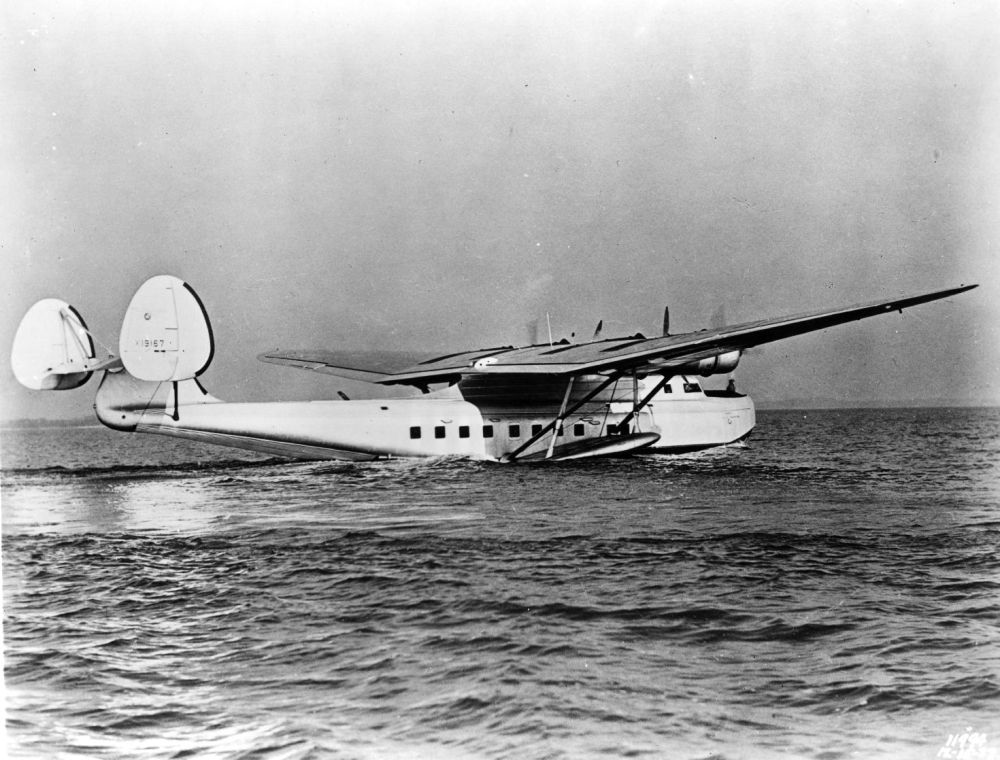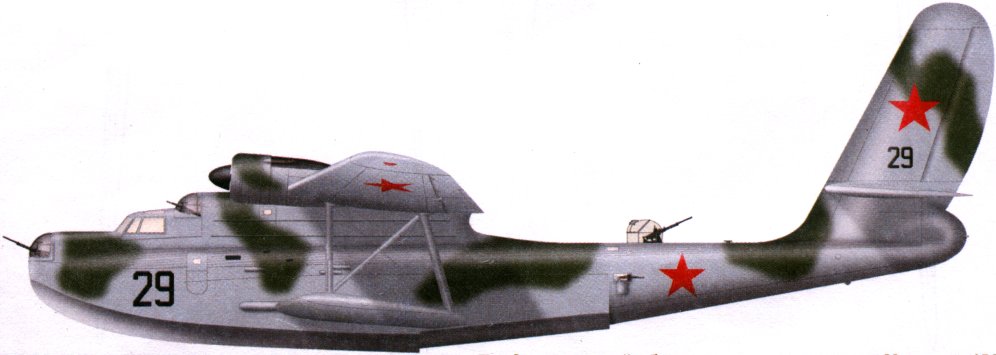
You may know the story of the three Martin Ocean Transport Model-130s (M-130) purchased by Pan Am Airways in 1935, but how about the lone model 156? Hopefully, this new accounting of the “Super Clipper” will be the most detailed to date thanks to information gleaned from old Soviet materials of Aeroflot airways.
On April 11,1936 the Soviet Council of Labor and Defense (SRT) of the USSR decided to purchase aircraft manufacturing licenses and technical assistance from the US to help ease an apparent backlog of aviation needs in the massive country (11 time zones long). Because of the long range requirements to cover the expanse, a large and small aircraft combination was sought and the Soviets selected the Consolidated Model 28 (PBY Catalina) and the still to be built Martin 156 “Russian Clipper “.
The M-156 appealed greatly to the Soviets due to its strong hull, stability while taxiing in choppy water, night flying capability and ample space for cargo, passengers and troops. By September 1936, the Martin company agreed to build the M-156 for 1.5 million dollars in the Soviet Union. Talks were held to build the tools, fuselage and other components in the Soviet Union at two aircraft factories: Plant No. 31 in Taganrog (Dmitrova) and Plant No. 126 in Komsomolsk-on-Amur. Later, a third for engine production was added called Plant No. 30 (Lyulka / NPO Saturn) in the city of Yaroslavi Oblast near the Rybinsk Sea (at the time the largest man-made body of water on the entire planet).

Later in 1937, Chief of Logistics Management of the Soviet Air Force – Brigade Commander Bazenkov, proposed the aircraft prototype be built in Baltimore instead at the Martin plant as production delays and errors in converting US measurements to metric had proven cumbersome.

By November 1937 the new M-156 (they called it the GM-156 for Glenn Martin) was christened N19167 and on November 27th, took to the sky from the Chesapeake Bay.

A Soviet crew flew to Maryland led by engineer Borisenko and pilot Ershov Kozlova on December 14th to observe the sea trials and areal performance of the largest passenger aircraft in America and by January 20th, she was on her way to the other side of the world.
The Russian Clipper was first flown to New York and then dismantled and boxed up to be placed onto an awaiting steamship direct to Leningrad. Some parts of the clipper like wings and fuselage were too large so they were secured on deck and tied down. For the Soviets, the buying and building process seemed to move fairly smooth so Chairman of the Board Amtorga Rozov requested Moscow to buy another clipper (model 157f) as a possible naval aviation ocean bomber and sling two – 1 ton bombs on each side.

Later, aviation engineer P.D. Samsonov proposed to position a bomb load in the fuselage and drop them through bottom hatches and turn it into a heavy bomber. The Commission concluded that the modifications would require massive structural changes and may compromise the integrity of the air frame on rough landings or impacts with the floating sea ice. Other suggested modifications included mounting gun turrets in the fore and aft end, an upper turret behind the trailing edge of the wing and machine-guns in the windows on the sides below the top turret.

Arguments soon arose against buying more GM-156 / 157s because of their limited use of on frozen water landing areas (only on the Black Sea would be ice free) and the need for massive aircraft handing infrastructure, coastal bases, mechanized slips, large heated repair hangars and winter parts storage. Other logistical issues arose out of the discussions which determined plant # 30 next to the Rybinsk Reservoir was covered with ice six months of the year and the plan to assemble and test the domestically created Martin variants in Taganrog and Sevastopol would be nearly impossible as the huge fuselage and wings could not be disassembled and fit on the existing railway system. The prevailing machining standards were also behind most western countries and far from satisfactory of Martin requirements.

In early 1938, Stalin was not liking the desire of his military leaders to buy “American” and began arresting and imprisoning the supporters of “Martina”. On April 11, 1938 an official document was published stating in part: “The boat was bought, as it turned out, from enemies of the nation after the Tupolev, Kharlamov, Chernyshev, etc. … Today, it is clear that the boat GM-156 [is] nothing of American technology and to equip the Navy is inappropriate “. Deputy Minister of Defense and Commander of the Soviet Navy Pyotr (Peter) Smirnov soon declared that all work on future aircraft would be halted due to the decrees of Stalin and that all parts, supplies and assets related to the new fabrications be scrapped and written off. Later in June, Smirnov was arrested and executed by firing squad in February of 1939. Fifteen of the sixteen total army commanders were executed and more than three-fourths of senior officers were arrested, executed, or relieved of duty.
In July 1938, as the Hawaii Clipper would soon be lost, Pilot A.V. Kržiževskij along with E. Schwartz, B. Matveev, B.A. Andrew and Lead Engineer L. Izraeckijcrew flew the Russian Clipper to the Ivankovskoye Reservoir just outside Moscow for use in civil aviation activities. Due to heavy boat traffic, the GM-156 was moved to the Pirenga Reservoir in Murmansk for maintenance and re-designated PS-30. From there it flew 17 missions in 1938 and another 39 mission in 1939.

Finally, in May 1940, it was decided to use the Russian Clipper now designated PS-30 (SSSR – L2940) as air transport for Aeroflot (meaning air fleet) between Khabarovsk and Petropavlovsk in Kamchatka, Russia. Pilot N.M. Derkunskogo, Aircraft Mechanic M.V. Tulikova and Radio Operator A. Tul′vinskogo ferried the aircraft to the Soviet 13th Transport Detachment in Petropavlovsk. During the hard winters, the clipper received wear and tear and was patched up however the engines were a different issue and was idled throughout the first half of 1941. It would see limited service moving passengers and cargo across the great expanses and endure persistent problems with the engines throughout 1942 (only flew 82 hours). At the start of 1943, Wright Engines allowed a license to the Soviets to produce the Wright SR-1820-F3. Around this time an entry in old Soviet records show the Russian Clipper actually carried Pacific based American Bomber crews that had crashed in the Kamchatka peninsula to internment camps (as directed by the Soviet-Japanese Treaty). The pilots were then flown to Tashkent (now Uzbekistan) where they remained until the end of the war (although some escaped to Iran and made it home).

GM-156 last flew in August 1944 and was locked down due to no more spare parts from the US. On April 29, 1945 the formal cancellation of PS-30 was approved and the clipper remained in the far eastern city of Khabarovsk until she was scrapped in July of 1946.







I’m quite sure that this is the Super Clipper on the way to Leningrad so must be February 1938 as it’s taken in Copenhagen Free port.
It’s on a ship from the company Moore & McGormack.
https://kbhbilleder.dk/kbh-museum/78865
LikeLike
I think this is a picture of The Martin 156 being transported to the Soviet Union. The picture is from the port of Copenhagen:
https://kbhbilleder.dk/kbh-museum/78864
LikeLike
Excellent footage of “X19167” landing can be seen at 58 minutes into the 1942 RKO picture “The Falcon’s Brother. The scene shows the plane in the distance and then pans close-up across the plane as it lands and starts to settle in the water. Elapsed time about 15 seconds.. The wing numbers are clearly visible. The plane is supposedly flying a foreign diplomat into the USA with Nazi spies plotting his execution.
LikeLike
Fantastic and thanks so much!!!
Cheers!
LikeLike